Goldfarb D. Biophysics DeMYSTiFied
Подождите немного. Документ загружается.


252 Biophysics D e mystifieD
DNA Tertiary Structure
The DNA double helix is not a rigid rod. The molecule is somewhat flexible,
not quite as flexible as a piece of thread or string but somewhat flexible like a
garden hose. The double helix itself it is able to bend and twist. Flexibility, or
rather stiffness, in polymers is often measured using persistence length. The
persistence length is the length of a segment of polymer that behaves as if it is
relatively rigid. Beyond the persistence length, the polymer can bend, so, the
shorter the persistence length, the more flexible the polymer.
Flexibility in DNA
One way to mathematically model the flexibility of a polymer is to consider it
to be a series of rigid segments that are freely jointed together. This means that
each segment is free to angle and rotate relative to its adjacent neighboring seg-
ments. The length of each segment is the persistence length of the polymer. In
reality the molecule may not be a chain of freely jointed rigid segments, but this
model often works well to predict properties of polymers that result from flex-
ibility. In this way we can mathematically describe the flexibility of DNA and
other biopolymers without the need to measure flexibility directly.
The freely jointed chain model allows us to calculate the root mean square
end-to-end distance. Each segment is treated as a vector pointing to the next
segment. The sum of all of these vectors is a single vector pointing from one
end of the chain to the other. Figure 10-18 illustrates this. We can calculate this
single end-to-end vector for all possible conformations of the freely jointed
chain. We would like to get some average value for this end-to-end vector, as a
way of characterizing the set of all possible conformations of the chain.
If we consider all possible conformations, the set of all possible end-to-end
vectors will include vectors in all different directions. Adding up these vectors
will result in some of the vectors canceling each other out (because they point
in opposite directions). The average vector will then be zero. We solve this
problem by squaring the end-to-end vector. Multiplying vectors together con-
verts them to scalars, so each squared vector is a scalar. We then sum all of the
squared end-to-end vectors and take the mean (average) of the squares. The
square root converts the units from distance squared back into a simple dis-
tance. This root mean square (RMS) end-to-end distance gives us one measure of
the compactness of the polymer. It turns out that for a freely jointed chain of
N segments, each of length L, the RMS distance is equal to the square root of
the number of segments times the length of each segment.
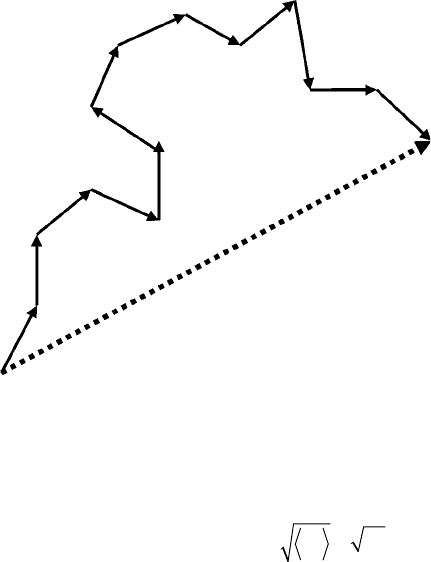
chapter 10 Nucleic Acid Biophysics 253
RMS end-to-end distance 5
rNL
2
=
(10-4)
Superhelical DNA
The most common DNA tertiary structure found in nature is a superhelix. The
double helix itself bends and curves such that the axis of the double helix also
forms a helix, as shown in Fig. 10-19. Superhelical DNA is sometimes referred
to as supercoiled DNA. However, be careful not to confuse the use of coil in
supercoil with the use coil in helix-coil transition. In the case of supercoil, we
mean a helix, as in superhelix. But in the case of a helix-coil transition, coil is
short for random coil. meaning the opposite of a helix. For this reason we will
generally try to avoid using supercoil, and stay with superhelix. But be aware that
many books and articles will use the word supercoil.
You can gain a lot of insight regarding superhelicity by taking a piece of gar-
den hose, or rubber tubing, grabbing it in two places (one with each hand) some
distance apart, and twisting it with your hands. The axis of the garden hose will
kink up, forming a helical shape. You can take the analogy further by painting
(or imagining) a double helix on the garden hose or rubber tubing. Then the
kinked up tube or hose truly is a superhelix relative to the double helix that’s
painted on the hose. Now here’s where the insight comes in. As you are holding
FIgure 10-18 • Freely jointed chain represented by a series
of vectors. The sum of these vectors is a single vector
pointing from one end of the chain to the other.
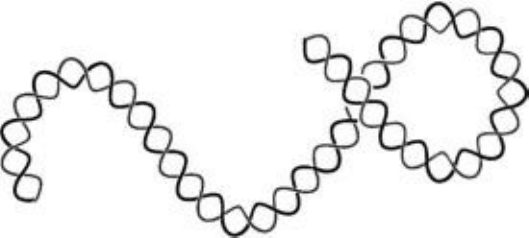
254 Biophysics DemystifieD
the kinked-up hose, let go with one hand. What happens? The superhelix goes
away. The hose relaxes. The same thing is true of DNA. Unless the ends of the
DNA molecule are somehow held in place, the superhelical tertiary structure
goes away. Regarding the secondary structure (the double helix) the DNA mol-
ecule has the necessary forces internally (base stacking, hydrogen bonds) to
maintain its secondary structure, but it cannot maintain the tertiary structure
of the superhelix without being somehow held in place. The tertiary structure
comes from the fact that the DNA double helix is partially flexible, but with
some elasticity, like a garden hose. This partial flexibility and elasticity come
from the base stacking, hydrogen bonds, and covalent bonds that hold the dou-
ble helix together. But, due to the elasticity, it requires some stress on the mol-
ecule in order to maintain the tertiary windings.
There are three ways that nature typically holds the ends of the DNA mol-
ecule in place in order to maintain superhelical windings. See Fig. 10-20. The
first is by binding the ends of the DNA or a portion of the DNA to a protein,
thus forming a loop of double helix. The second is simply by winding the
double helix around a protein complex. This is the most common way to main-
tain superhelicity in eukaryotes. The protein complex with DNA wrapped
around it is called a nucleosome. The third way to hold the double helix in place
to maintain superhelicity is for the two ends of the double helix to be cova-
lently attached to one another forming a circular molecule. Circular DNA mol-
ecules are most common in bacteria and other prokaryotes.
Once the ends of the double helix are held firm, if the double helix is twisted
(or untwisted) to an extent that is different from its normal amount of helical
twist, the stress of this twisting will cause the axis of the double helix to kink
up. This kinking up is the superhelix. We can best understand the nature of
FIgure 10-19 • The DNA double helix can bend and curve its axis into a
helical shape. This helix of a helix is called a superhelix.
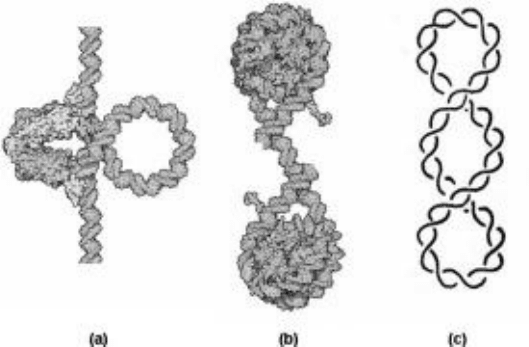
chapter 10 Nucleic Acid Biophysics 255
superhelix formation by studying circular DNA. This is the third case (c) in Fig.
10-20. Circular DNA is uncomplicated by the need for bound proteins to
maintain superhelicity. The principles and the relationship between the double
helix and the superhelix are the same in any case. But the ability to examine
these principles with regard to DNA alone (without bound proteins) simplifies
our understanding.
Geometry and Topology of Superhelical DNA
The branch of geometry and mathematics that deals with objects being bent or
deformed in a continuous manner is called topology. The bending of the double
helix to form a superhelix therefore falls into this area of mathematics. In a
circular, double-helical DNA, the two ends of the double helix are covalently
bonded together forming a double-helical circle. This type of DNA is called
closed duplex DNA, closed because the DNA strands each form a closed and
continuous circle and duplex because there are two strands of DNA. [The term
circular DNA can also refer to a single-stranded circular DNA molecule; there-
fore to be more exact, we use the term closed duplex DNA (cdDNA)]. Closed
duplex DNA is found in nature in many organisms and can also be synthesized
in the laboratory.
FIgure 10-20 • Three ways to hold DNA double helix into a superhelical
conformation. (a) The ends of a portion of double helix are held in place by
a protein. (b) The double helix is wound around a protein complex called a
histone. (c) The two ends of the double helix are covalently attached to
one another, forming a circular molecule.

256 Biophysics DemystifieD
Each of the two strands of a cdDNA are themselves continuous, closed cir-
cles. But because of the intertwining of the double helix, the two strands are
linked to one another like two links in a chain. Figure 10-21 illustrates two
closed curves as a way of representing the two circular strands of DNA in a
cdDNA molecule. The figure shows the two curves linked together one, two,
and six times. Although the links of a chain are typically linked together only
once, two intertwining, circular strands can wrap around each more than once.
The number of times that one strand is linked to the other strand is called the
linking number and is denoted by Lk. The linking number is a topological invari-
ant; it does not change under continuous changes of shape. Only if one or both
of the DNA strands is broken (a noncontinuous, or discontinuous, change of
shape) can the linking number change.
In the field of topology, regarding linked curves, there are two more param-
eters that are directly useful for studying and understanding closed duplex
DNA. The first is twist, denoted by Tw. The twist is the number of times one
curve wraps around the other along the entire length of the curves. For the
curves shown in Fig. 10-21, the twist is exactly equal to the linking number.
Whenever the twist is equal to the linking number, then the two curves (except
to the extent that they twist around each other) will lie entirely within a plane
FIgure 10-21 • The linking number Lk is a topological invariant
of two or more closed curves. The drawing shows, from left to
right, two closed curves that are linked in space one, two, and six
times respectively. The center pair of drawings is intended to
illustrate that, no matter how the curves are bent or twisted
(continuous deformations of shape) the number of times that the
two curves are linked together remains constant. The linking
number can only be changed by breaking and resealing one or
both curves in at least one location along the curve.

chapter 10 Nucleic Acid Biophysics 257
or, more precisely, entirely on the surface of a sphere. This is the case in Fig.
10-21; the curves as shown (except where they twist around each other) lie
entirely within a plane, or more precisely entirely on the surface of a large
sphere. (Note: The sphere can be large or small, whichever is necessary. The
point is that if Tw is equal to Lk, then it will always be geometrically possible
to define a sphere such that the curves lie entirely on the surface of that sphere.
This is the correct way to describe the case where Tw equals Lk. Regarding the
idea of lying within a plane, this is used for convenience because it is often
simpler to visualize the curves lying within a plane than on a surface of a
sphere; the concept of lying within a plane works just as well because a plane
is effectively the surface of an infinitely large sphere.)
If the twist is not equal to the linking number, then it is not possible for the
curves to lie on the surface of a sphere or plane. We will not prove this topologi-
cal theorem, but take it as a given. Those of you who are interested can cer-
tainly look it up in any decent book on topology or on the Web. The curves,
instead of lying in a plane, will bend, or kink, rising above or below the plane.
The extent to which the curves are not able to lie in a plane or on the surface
of a sphere (but rise above or below it) is another topological parameter called
writhe, and denoted by Wr. There is a simple mathematical relationship between
the linking number, the twist, and the writhe, given by
Wr 5 Lk 2 Tw (10-5)
As we saw in Table 10-1, depending on the particular conformation of DNA,
the various forces (base stacking, hydrogen bonds, etc.) stabilize the double
helix to have a particular amount of helical pitch. In Table 10-1 this parameter
was expressed in terms of the length in angstroms of a single turn of the helix.
In a circular DNA there is obviously a relationship between the pitch of the
helix and the twist expressed in terms of the number of times one strand winds
around the other for the entire circumference of the circle. For a given cdDNA,
the twist will be the circumference of the circular DNA divided by the pitch
of the helix.
Tw =
circumference
helical pitch
(10-6)
The DNA double helix has a preferred (most favorable, most stable) helical
pitch, which is defined as the point where the Gibbs energy of helix formation
is at a minimum (is most negative). The facts that there is a most stable helical
pitch and that for a circular DNA there is a direct relationship between the heli-
cal pitch and the twist [Eq. (10-6)] means that there is a most stable amount of
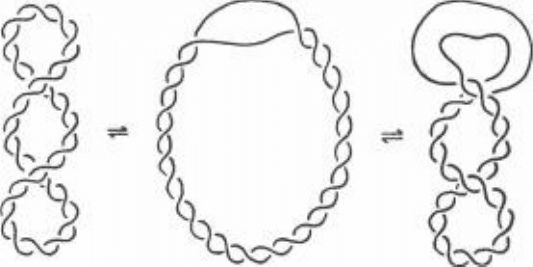
258 Biophysics DemystifieD
twist. If the most stable amount of twist differs from the linking number, then
the DNA will writhe, according to Eq. (10-5). In other words the axis of the
double helix will not lie within a plane, but will curve and bend forming a super-
helix. Figure 10-22 illustrates this. On the left side of the figure is a cdDNA in
which the most stable amount of twist is 14, but the linking number is only 12.
Therefore the cdDNA writhes, forming supercoils. In this state the DNA is said
to be negatively supercoiled, because the writhe is negative.
In the middle of Fig. 10-22 we have unwound some of the base pairs (per-
haps by raising the temperature). Assuming 10 base pairs per turn of the double
helix, if we melt 20 base pairs, then we unwind two turns of the double helix.
Removing two turns of the double helix reduces the twist from 14 to 12. Now
the twist is equal to the linking number, the writhe is equal to zero, and the axis
of the cdDNA lies on the surface of a sphere or within a plane. This is an impor-
tant result. It means that unwinding negatively superhelical DNA reduces
superhelicity. Superhelical DNA found in nature is almost always found to be
negatively supercoiled.
In the final drawing on the right side of Fig. 10-22, we have melted additional
20 base pairs, bringing the value of Tw down to 10. Now the twist is less than
the linking number. This forces the molecule to have a positive writhe, and the
cdDNA now becomes superhelical in the positive direction. This is also a very
important result. It means that if we unwind enough base pairs, then the DNA
eventually becomes superhelical with a positive writhe. This is extremely
Lk = 12
Tw = 14
Wr = –2
Lk = 12
Tw = 14
Wr = 0
Lk = 12
Tw = 10
Wr = +2
FIgure 10-22 • Representation of a cdDNA molecule with Lk 5 12 and
different amounts of twist (Tw).
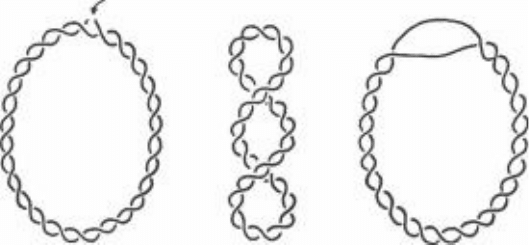
chapter 10 Nucleic Acid Biophysics 259
important, because transcription and replication involve unwinding a lot of
base pairs. As we unwind more and more base pairs to transcribe or replicate
the DNA, positive supercoils form in front of the replication (or transcription)
fork. As we unwind more and more double helix, more and more superhelix
forms in the still wound portions of the molecule. Bending the axis of the
double helix requires energy, and if we bend it enough it could eventually break
or at least encounter steric hindrances. The cell has to somehow reduce this
positive supercoiling, and it does so with the aid of enzymes called topoi-
somerases. Topoisomerases are enzymes that change the level of supercoiling in
DNA by changing the linking number Lk. Individual DNA molecules that are
identical except for Lk are called topoisomers (short for topological isomers).
Nicked Duplex DNA
What happens if we break one of the strands in a closed duplex DNA? If we
break one of the strands of a cdDNA, then the strands are free to turn around
each other, and there is no longer a constraint that the linking number must
remain constant. In fact, strictly speaking Lk is no longer defined. The ends of
the double helix are also no longer held in place, which (as noted previously)
is necessary to maintain a superhelix. What happens, as illustrated in Fig. 10-23,
is that the axis of the helix is free to relax; the writhe goes to zero. A circular,
Nick
ndDNA
Tw = 14
Wr = 0
cdDNA
Lk = 12
Tw = 14
Wr = –2
cdDNA
Lk = 12
Tw = 12
Wr = 0
FIgure 10-23 • Representation of a ndDNA molecule with Tw 5 14, and
a cddNA molecule with Lk 5 12 and different amounts of twist (Tw). When
a cdDNA is nicked, the force holding the supercoils in place is removed,
and the molecule relaxes until the writhe equals zero.
260 Biophysics De mystifieD
double-helical DNA with one or more breaks in one or more strands is called
nicked duplex DNA (ndDNA). If both strands are broken, as long as the breaks
are not directly across from one another and conditions are favorable for a
double helix to form, then the molecule will remain circular.
The fact that a ndDNA will spontaneously relax (the writhe will spontane-
ously go to zero) is indicative of the fact that there is energy bound up in the
superhelix. Once we remove the structural constraint of holding the ends of
the double helix in place (by being covalently attached to one another), then
the molecule is free to seek a lower Gibbs energy value. In the case of a nega-
tively superhelical closed duplex DNA, unwinding the double helix will initially
reduce the writhe (as we saw in Fig. 10-22). The energy of that writhe can
contribute to unwinding the double helix. This means that unwinding base
pairs in a negatively superhelical DNA is easier (requires less energy from the
outside) than it is in a linear or ndDNA. The opposite is true for positive super-
helical DNA. Unwinding base pairs in positively supercoiled DNA increases
superhelicity; this makes it more difficult to unwind the DNA further.
Topoisomerases
As we mentioned briefly above, the cell contains enzymes capable of altering
the linking number of DNA. These enzymes are called topoisomerases. Topoi-
somerases alter the linking number by temporarily breaking one or both strands
of DNA. (Recall that Lk is a topological invariant; it cannot be changed by
continuous deformations of shape but only by breaking one or both strands of
DNA.) There are two classes of topoisomerases. Type I topoisomerases change
the linking number by breaking only one strand of DNA, then allowing or forc-
ing one of the strands to wind or unwind around the other, and then resealing
the covalent bond that was broken. Type II topoisomerases break both strands of
DNA, and then pass a section of unbroken double helix through the break
before resealing the covalent bonds. In this way type II topoisomerases always
change the linking number two at a time, for example, from 14 to 16 to 18, and
so on. Type I topoisomerases can change the linking number only one at a time,
for example, from 14 to 15 to 16, and so on.
Most topoisomerases reduce the amount of writhe, regardless of whether the
writhe is positive or negative. These topoisomerases effectively allow the DNA
to relax while one or both strands of the molecule are temporarily broken. This
releases some of the energy that is in the writhing. Some topoisomerases, known
as gyrases, are able to increase negative writhe by reducing the linking number.
Increasing the absolute value of writhe requires energy (to bend the DNA into
chapter 10 Nucleic Acid Biophysics 261
a superhelix). This energy comes from ATP. Gyrases couple their topoisomerase
reaction with cleaving one of the high-energy phosphate bonds in ATP and
utilizing that energy to increase the writhe in DNA. In this way the cell can
store energy in the elasticity of the DNA (like winding up a spring),which can
later be used to help unwind the DNA for transcription or replication. It can
also, to some extent, control the onset of transcription or replication, by altering
the superhelicity; this in turn affects how easy or difficult it is to unwind a
particular region of DNA.
